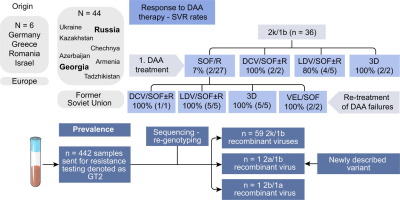当前位置:
X-MOL 学术
›
J. Hepatol.
›
论文详情
Our official English website, www.x-mol.net, welcomes your
feedback! (Note: you will need to create a separate account there.)
Origin, prevalence and response to therapy of hepatitis C virus genotype 2k/1b chimeras
Journal of Hepatology ( IF 26.8 ) Pub Date : 2017-10-01 , DOI: 10.1016/j.jhep.2017.05.027 Simone Susser , Julia Dietz , Bernhard Schlevogt , Eli Zuckerman , Mira Barak , Valeria Piazzolla , Anita Howe , Holger Hinrichsen , Sandra Passmann , Rasha Daniel , Markus Cornberg , Alessandra Mangia , Stefan Zeuzem , Christoph Sarrazin
Journal of Hepatology ( IF 26.8 ) Pub Date : 2017-10-01 , DOI: 10.1016/j.jhep.2017.05.027 Simone Susser , Julia Dietz , Bernhard Schlevogt , Eli Zuckerman , Mira Barak , Valeria Piazzolla , Anita Howe , Holger Hinrichsen , Sandra Passmann , Rasha Daniel , Markus Cornberg , Alessandra Mangia , Stefan Zeuzem , Christoph Sarrazin

|
BACKGROUND & AIMS
Little is known about the epidemiology and frequency of recombinant HCV genotype 2/1 strains, which may represent a challenge for direct antiviral therapy (DAA). This study aims to identify the epidemiology and phylogeny of HCV genotype 2/1 strains and encourages genotype screening, to select the DAA-regimen that achieves the optimal sustained virologic response. METHODS
Consecutive samples from HCV genotype 2 infected patients, according to commercial genotyping, from Germany, Italy and Israel were re-genotyped by Sanger-based sequencing. Virologic, epidemiological, and phylogenetic analyses including other published chimeras were performed. RESULTS
Sequence analysis of 442 supposed HCV genotype 2 isolates revealed 61 (genotype 2k/1b (n=59), 2a/1b (n=1) or 2b/1a (n=1)) chimeras. No chimeras were observed in Italy, but the frequency was 14% and 25% in Germany and Israel. Treatment of viral chimera with sofosbuvir/ribavirin led to virologic relapse in 25/27 patients (93%). Nearly all patients treated with genotype 1-based DAA-regimens initially (n=8/9), or after relapse (n=13/13), achieved a sustained virologic response. Most patients with 2k/1b chimeras (88%) were originally from eight different areas of the former Soviet Union. All known 2k/1b chimeras harbour the same recombination breakpoint and build one phylogenetic cluster, while all other chimeras have different phylogenies. CONCLUSIONS
The HCV genotype 2k/1b variant derives from one single recombination event most likely in the former Soviet Union, while other chimeras are unique and develop independently. A relatively high frequency has been observed along the migration flows, in Germany and Israel. In countries with little migration from the former Soviet Union the prevalence of 2k/1b chimeras is expected to be low. Treatment with sofosbuvir plus ribavirin is insufficient, but genotype 1-based regimens seem to be effective. Lay summary: The frequency of recombinant HCV is higher than expected. A novel recombinant variant (HCV genotype 2a/1b) was identified. Screening for recombinant viruses would contribute to increased response rates to direct antiviral therapy.
中文翻译:

丙型肝炎病毒基因型2k/1b嵌合体的起源、流行和治疗反应
背景和目的 关于重组 HCV 基因型 2/1 菌株的流行病学和频率知之甚少,这可能代表直接抗病毒治疗 (DAA) 的挑战。本研究旨在确定 HCV 基因型 2/1 菌株的流行病学和系统发育,并鼓励基因型筛选,以选择实现最佳持续病毒学反应的 DAA 方案。方法 根据商业基因分型,来自德国、意大利和以色列的 HCV 基因 2 型感染患者的连续样本通过基于 Sanger 的测序进行重新基因分型。进行了病毒学、流行病学和系统发育分析,包括其他已发表的嵌合体。结果 442 个假定的 HCV 基因型 2 分离株的序列分析揭示了 61 个(基因型 2k/1b (n=59)、2a/1b (n=1) 或 2b/1a (n=1))嵌合体。在意大利没有观察到嵌合体,但德国和以色列的频率分别为 14% 和 25%。用索非布韦/利巴韦林治疗病毒嵌合体导致 25/27 名患者 (93%) 的病毒学复发。几乎所有最初(n=8/9)或复发后(n=13/13)接受基于基因型 1 的 DAA 方案治疗的患者都获得了持续的病毒学应答。大多数 2k/1b 嵌合体患者 (88%) 最初来自前苏联的八个不同地区。所有已知的 2k/1b 嵌合体都具有相同的重组断点并构建一个系统发育簇,而所有其他嵌合体具有不同的系统发育。结论 HCV 基因型 2k/1b 变体源自最有可能发生在前苏联的一个单一重组事件,而其他嵌合体则是独特的并独立发展。在德国和以色列的移民流中观察到相对较高的频率。在前苏联移民很少的国家,2k/1b 嵌合体的流行率预计较低。用索非布韦加利巴韦林治疗是不够的,但基于基因型 1 的方案似乎是有效的。外行总结:重组HCV的频率高于预期。鉴定了一种新的重组变体(HCV 基因型 2a/1b)。重组病毒的筛选将有助于提高对直接抗病毒治疗的反应率。
更新日期:2017-10-01
中文翻译:

丙型肝炎病毒基因型2k/1b嵌合体的起源、流行和治疗反应
背景和目的 关于重组 HCV 基因型 2/1 菌株的流行病学和频率知之甚少,这可能代表直接抗病毒治疗 (DAA) 的挑战。本研究旨在确定 HCV 基因型 2/1 菌株的流行病学和系统发育,并鼓励基因型筛选,以选择实现最佳持续病毒学反应的 DAA 方案。方法 根据商业基因分型,来自德国、意大利和以色列的 HCV 基因 2 型感染患者的连续样本通过基于 Sanger 的测序进行重新基因分型。进行了病毒学、流行病学和系统发育分析,包括其他已发表的嵌合体。结果 442 个假定的 HCV 基因型 2 分离株的序列分析揭示了 61 个(基因型 2k/1b (n=59)、2a/1b (n=1) 或 2b/1a (n=1))嵌合体。在意大利没有观察到嵌合体,但德国和以色列的频率分别为 14% 和 25%。用索非布韦/利巴韦林治疗病毒嵌合体导致 25/27 名患者 (93%) 的病毒学复发。几乎所有最初(n=8/9)或复发后(n=13/13)接受基于基因型 1 的 DAA 方案治疗的患者都获得了持续的病毒学应答。大多数 2k/1b 嵌合体患者 (88%) 最初来自前苏联的八个不同地区。所有已知的 2k/1b 嵌合体都具有相同的重组断点并构建一个系统发育簇,而所有其他嵌合体具有不同的系统发育。结论 HCV 基因型 2k/1b 变体源自最有可能发生在前苏联的一个单一重组事件,而其他嵌合体则是独特的并独立发展。在德国和以色列的移民流中观察到相对较高的频率。在前苏联移民很少的国家,2k/1b 嵌合体的流行率预计较低。用索非布韦加利巴韦林治疗是不够的,但基于基因型 1 的方案似乎是有效的。外行总结:重组HCV的频率高于预期。鉴定了一种新的重组变体(HCV 基因型 2a/1b)。重组病毒的筛选将有助于提高对直接抗病毒治疗的反应率。











































 京公网安备 11010802027423号
京公网安备 11010802027423号